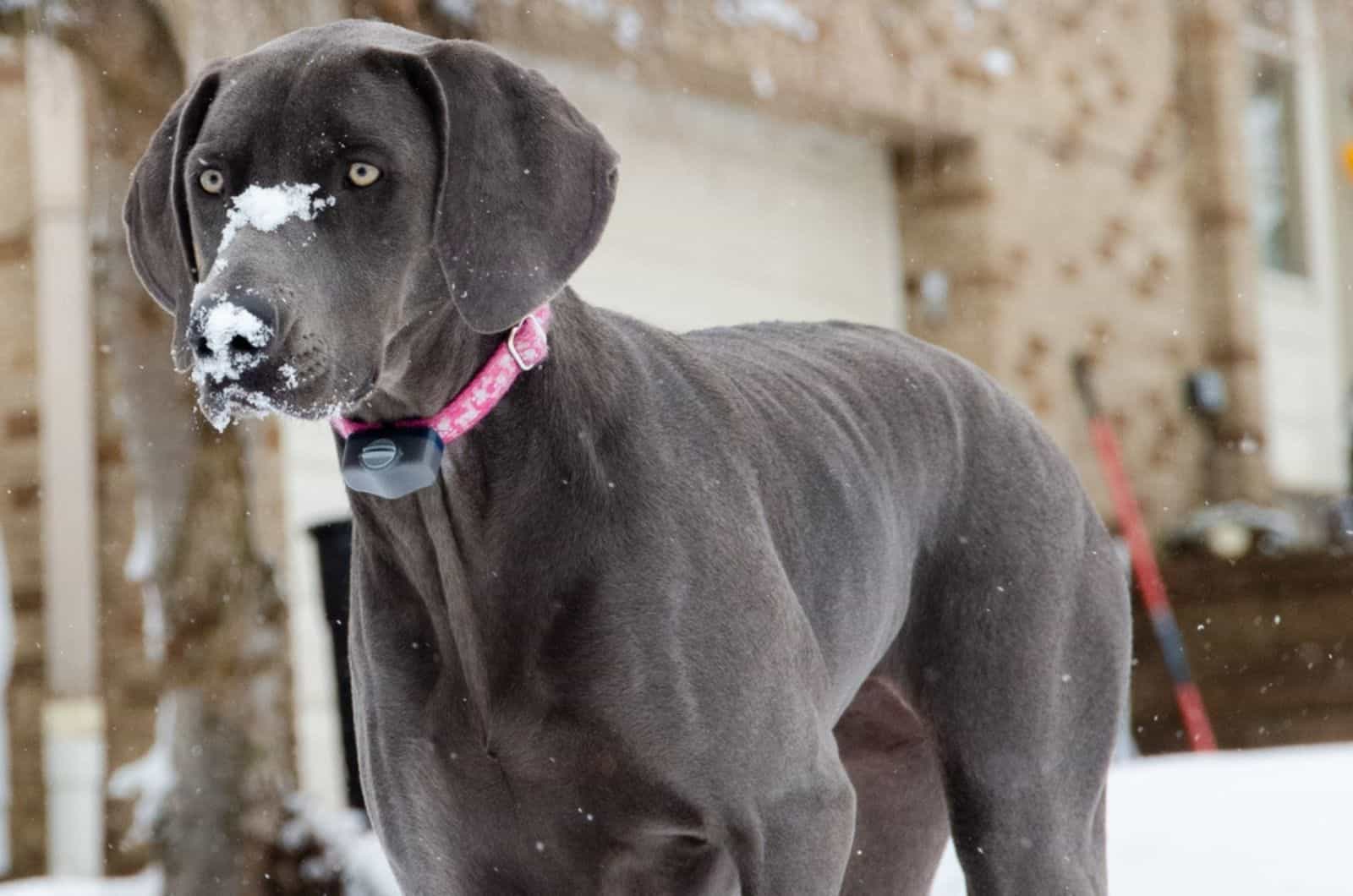Germany is a country that gave the world some of the most popular and well-regarded dog breeds. Somewhere along the line, we replaced our want with a need for a canine companion, with owning one becoming the norm for many.
The dog world has many look-alikes, and the blue Weimaraner dwells close to the Labrador Retriever in terms of appearance. Although it does not come close to the Lab’s status of USA’s darling, the Gray Ghost of Deutschland is a famed hunting dog.
Its role expands far beyond this singular purpose. Chasing game and performing physically intense tasks comes to a close at one point, and the time for resting beside its human companion takes precedence then.
Dogs cannot choose the color of their human companion, but we put it on ourselves to not only pick and choose but also create new colors by breeding dogs with suitable genes. This is the allegory of the blue Weimaraner.
Everything Starts With The Bloodline Of A Blue Weimaraner

Inherited traits are a gift from our parents. Having blonde hair and blue eyes or brown hair and brown eyes is something that defines us as part of a particular bloodline. In the same manner, the blue Weimaraner is representative of its ancestors.
In 1947, a Weimaraner dog carrying the name Cäsar von Gaiberg was born. With his impressive look and performance, he was brought to the States a few years later. Despite being a product of inbreeding, this dog’s genes were the foundation of a large majority of blues in the US.
This gray Weimaraner has been the subject of many a debate regarding the origin of its color. Some theorized that it was due to cross-breeding with the Doberman, while others said that the dilution was a naturally occurring mutation that became a mainstay in the breed.
It is no secret that the color “blue”, in reality, is a gray color created through the effort of breeding Weimaraners of the same color. Blue-gray eyes, sometimes replaced by amber-colored ones, earned the breed the legendary name of German Gray Ghost.
A blue coat in many dog breeds raises eyebrows. Questions about purity, health, or genetic nature are raised whenever dilution is mentioned. The diluted pigment is not a concern, especially for the purebred Weimaraner, due to its frequent presence within the breed.
Moving away from the politics and policies deciding the blue Weimaraner’s position in the eyes of dog show judges, we can find solace in the process of how the blue color develops in a Weimaraner puppy. That is exactly where we are going next.
Diluted Pigments, Recessive Genes, And Loci That Make The Blue Weimaraner

Thanks to two pigments, eumelanin (black) and phaeomelanin (red), dogs can express an incredibly diverse palette of colors and patterns. Blue Weimaraners are quite a conservative dog breed in this regard.
All of the breed’s colors are based on the dilution of the black pigment. The options of blue, charcoal gray, silver-gray, and mouse-gray make it one of the few breeds, if not the only one, that does not have an undiluted solid coat color.
One gene from each Weimaraner puppy parent participates in the genesis of coat colors, and the process is by no means simple.
These genes or variations of them (alleles) are placed on loci (locations of a gene on a chromosome), whose function as checkpoints is to decide whether to inhibit, stop, or start the production of a pigment.
Dominant and recessive gene pairings will determine the outcome, passing on the responsibility of deciding to another locus. In several situations, these loci interact with one another, mixing and matching multiple colors in specific amounts and areas of the body.
Our friendly, loyal, and zealous canine from the German region of Weimar is not wealthy in colors and patterns, but its qualities lie elsewhere. This, however, does not mean a blue Weim’s coat is less worthy of a detailed explanation.
1. Black Or Red/Yellow
No matter the color of a dog, the starting point for every single coat color decision is the E locus. The melanocortin 1 receptor (MC1R) gene is the on-and-off button for eumelanin production.
With two dominant genes (E/E) or a dominant and recessive (E/e) pair on this locus, the production of black pigment will not be impeded. The deactivation of eumelanin ensues only if two recessive genes (e/e) are present on the E locus. This will result in red or yellow coat color.
Because the blue Weimaraner is a black pigment dilute, the next step toward the blue coloration is determined by loci K, B, and A.
2. Solid Or Patterned
For a dog to have a solid black, brown, or diluted coat color, the K locus must have one dominant gene (K) as part of the pairing. Inherently, the combinations of KB/KB, KB/Kᵇʳ, or KB/kʸ all yield the same result.
In the case of Kᵇʳ (the brindle pattern), there is not yet enough information on how to detect this particular allele, but it is known to be the second dominant gene on the K locus. Since the aim is a blue color, our Weimaraner will have the dominant black pairing.
Although we know that the blue Weimaraner will have this combination of genes on a specific locus, at the moment the process unfolds, loci B and A will be ready to take over the next decision.
However, the A locus will be excluded from participation as it only becomes actively involved with a pairing of recessive kʸ genes. With dominant black pairings, there will be no expression of patterns from the Agouti (ASIP) gene.
3. Black Or Brown
Conveniently, the B locus determines whether the dog will have a black or brown solid coat color. A dominant pairing of B/B or dominant and recessive B/b will express a black phenotype (visually observable characteristics of genetic build or genotype).
Double recessive genes or b/b on a DNA test signify a brown coat color will be the Weimaraner’s phenotype. Although the gray and silver-gray Weim are all called “shades of gray”, they are actually a brown dilute colloquially known as liver or Isabella.
It is clearly visible from pictures of these two coat colors that there is a brownish undertone without being too obvious. Comparing a blue Weimaraner and a silver or silver-gray one makes it more apparent.
4. The Blue Finale
Closing this diagram of coat coloring is the D locus, known as the dilute gene. Blue Weimaraners are only achievable if both parents have diluted black pigment phenotypes. This means that only a d/d or recessive gene pairing can create a blue coat color.
When there is a combination of a dominant and recessive gene on the D locus, the puppies will be carriers of the gene only. No phenotype expression means the dog will not have a diluted coat color.
For this D/d pairing, half of the litter will carry the dominant and the other half the recessive gene. In the case that a carrier dog is bred to another carrier, the litter will most likely have a diluted coat color.
Even if both parents are only carriers, the puppies can inherit the recessive genes from either and display the dilute phenotype. The double recessive pairing will pass on the d allele to the entire litter.
It is the same rule for two dominant D/D genes on the D locus — the entire litter will inherit only the non-dilute gene, which means there is no possibility of a diluted coat in the litter.
A Look Into The Blue Weimaraner’s Physical And Temperament Traits
The preservation of the breed in the aftermath of WWII was an important aspect of the modern-day blue Weimaraner and its other diluted variants, which was nothing short of a success.
American veterans brought some of the best specimens back into the US with the intent of keeping the best bloodlines alive, making it one of the most popular breeds of the fifties. Here is what breeders established as a Weimaraner breed standard.
According To Specifications

A male Weimaraner will grow between twenty-five and twenty-seven inches tall with a weight of seventy to ninety pounds. Females are slightly smaller at twenty-three to twenty-five inches in height and weigh in between fifty-five and seventy-five pounds.
If you cannot make your mind up about which sex will be a better fit for you and your home, we dissected this matter in this male vs female Weimaraner article.
The muzzle is the same length as the skull from the stop to the occipital bone. This gives the Weimaraner a touch of class with the moderately elongated head. The eyes can be light amber, gray, or blue-gray and are well set in the eye sockets.
Two long ears set well wide apart are lobe-shaped and folded at the top with a forward-facing direction. The neck should be medium-length and not overly muscular but well-developed.
It connects to a set of muscular shoulders, with a moderately wide but deep chest in between the forelegs. The hind legs are balanced with the front, but a slight tuck at the loin makes them appear slightly more substantial.
As with most hunting or retriever dogs, the feet are webbed and proportionate to the leg bone girth. Just like the nails, the paw pads should be gray or amber-colored and dewclaws removed.
The back must be straight with a subtle slant at the end of the hip socket. It continues into a tail that is carried flat when the dog is at rest but carried high and almost upright when alert. Undocked tails are a major fault and will result in a penalty.
Coat, Colors, And Grooming
A blue Weimaraner’s physical difference stands out only in terms of coat color. The quality of its coat is short and smooth without an undercoat. In terms of standard shades, any gray is allowed, but black and blue are not allowed in conformation events.
Still, purebred blue Weims can be AKC-registered and participate in agility, obedience, and other competitions that do not require a particular color standard to be met.
Although the blue color was previously recognized by the American Kennel Club, the Weimaraner Club of America pushed for the change in show standards, so now a blue Weim cannot be shown, i.e., it is an automatic disqualification.
Being the only one allowed, the gray coat can vary in shade from what is called mouse-gray to silver-gray. Additionally, markings are not allowed except for a small patch of white on the chest.
Weimaraners are moderate shedders, but due to their short and smooth single coat, grooming them a few times per week will be more than enough. Keep in mind that they are not allergy-friendly dogs despite having short hair.
The Blue Weimaraner Temperament

A German gray dog was always going to be a handful. Earning its stripes at hunting grounds, the high-energy blue Weimaraner loves nothing more than being among the trees, grass, bushes, and water. Of course, the color does not make a difference in temperament, so all Weims are like this.
This breed belongs to the sporting group of dogs, which means it is equally good at agility, obedience, tracking, and many more competitions that require a purpose-driven mind.
The Weimaraner’s working ethic needs a good amount of mental stimulation, but you should be able to avoid misbehavior with rigorous sessions of focused training. These dogs love learning new stuff, so their trainability and curiosity marks are high.
Hunting dogs are pack animals, and the Weim’s family members will be the most important humans without a doubt. Thanks to pronounced protective instincts, the breed is a great choice for homes looking to get a watchdog.
Being moderate barkers, you might have some complaints from the neighbors if you live in an apartment. Even though the Weimaraner thrives in open spaces and houses with big yards are preferred, it is an adaptable canine for its energy level.
Lots of serious work require serious playtime, so be prepared to engage in some goofing around multiple times per day. No matter how playful you are, the Weim is going to beat you. They are not the biggest cuddlers but are extremely affectionate with their family.
Socialization
Despite the breed’s will to please the owner, a highly active dog that does not receive enough physical exercise will become unruly. For this reason, it is not a good dog for first-time dog owners.
They are undeniably patient and loving with young children but moderately reserved towards strangers. If you entertain guests often or have a busy neighborhood, make sure your Weimaraner is exposed to those external factors from puppyhood.
If you have a Weimaraner rescue that has not been socialized, make sure to introduce it to different unknown stimuli at a slow and steady pace. They do not respond well to negative reinforcement, which means you will need patience and positive reinforcement training to get the best out of it.
Living with other dogs is manageable with this breed, but it is not ideal. Puppies that are properly raised around dogs or animals, in general, will be a delight to cohabitate with. Being very intelligent and sensitive, they can easily become scared of things that are unfamiliar to them.
Do not forget that Weims are pack animals that love being with their family all the time. Leaving them alone for prolonged periods of time can make them develop separation anxiety. This can cause unnecessary stress for both you and the dog, which can escalate into pandemonium.
Teach your Weimaraner puppy to appreciate time alone. Crate training can be a great way to “draw” the perimeter around the relaxation zone. Definitely consider reading about our best interactive dog toys to help your pup kill some time while you are away.
Blue Weimaraner Health Issues And Life Expectancy

Contrary to popular belief, the blue Weimaraner’s dilute gene does not cause any health issues. One hereditary condition that stems from a genetic mutation is color-dilution alopecia. This condition is exceptionally uncommon, and the Weimaraner is not even predisposed to it.
With that out of the way, let me just say that any dog can be predisposed to congenital health issues if the breeder breeds dogs of poor health. Rest assured, a blue Weim is as healthy as any other color Weimaraner.
Still, there are genetic diseases that the Weimaraner Club of America recommends all breeders and owners perform adequate DNA tests that can reveal the genes responsible for each condition. The following tests apply to the Weimaraner.
Autoimmune Thyroiditis
Lymphocytic thyroiditis is the leading cause of hypothyroidism in dogs. A thyroid gland that does not produce enough thyroxine and triiodothyronine slows down the metabolism and causes problems with nutrient absorption, body temperature regulation, etc.
The autoimmune part means that the immune system recognizes the cells the thyroid gland is built out of as foreign bodies that require an immune reaction. By killing off the structural parts of the gland, its hormone production rate plummets, causing major problems for the body.
Common symptoms include lethargy, weight gain, worsening coat quality, slow heart rate, etc. The treatment consists of lifelong hormone replacement therapy alongside diet and general lifestyle changes.
Hyperuricosuria
Uric acid is a trigger that activates an immune response, and as such, it plays a key role in tissue healing processes. Weimaraners, among other dog breeds, are predisposed to this condition due to the frequency of a gene mutation that causes hyperuricosuria.
Essentially, this disease causes excessive amounts of uric acid to be secreted. Its accumulation in the kidneys can create kidney stones or uroliths, leading to potentially fatal outcomes in male dogs if the urinary tract is blocked.
The most common symptoms are increased frequency of urination, blood in urine, and inability to urinate or control urination.
Smaller stones can be successfully treated with a catheter extraction, but more severe cases require open surgery. Secondary management after surgery is crucial to prevent recurring hyperuricosuria and includes low-purine diets, increased water intake, and sometimes meds.
Hypomyelination
Myelin is the protective and insulative layer that surrounds axons. These segments of the nerve have the role of transferring neural impulses to nearby cells. The myelin that surrounds the axon is supposed to protect it from outside influences but also facilitate signal transmission.
With hypomyelination, the dog’s body does not produce sufficient amounts of myelin, causing the axon to be exposed and overstimulated. The condition affects the central nervous system and is often called “shaking puppies” since the onset of tremors begins only a day after birth.
In cases when hypomyelination affects the peripheral nervous system, the onset of symptoms is between seven and nine weeks of age. Symptoms include general weakness, ataxia, low or non-existent reflexes, and loss of muscle mass.
With CNS HYM, the symptoms improve and eventually resolve as the dog gets older in all breeds except Samoyeds and Springer Spaniels. However, the symptoms of PNS HYM can never resolve and often carry with them a low quality of life for the dog.
Despite potentially knowing the causes of HYM, no effective treatment exists. Weimaraners are in the high-risk group for HYM, so make sure your breeder performs these tests before you buy a puppy.
Hypertrophic Osteodystrophy
Weimaraner puppies grow very quickly, and HOD is a condition that usually affects the growth plate of the metaphysis region of long bones. Essentially, the inflammation occurs due to the body’s inability to mature the cartilage into the solid bone during puppy growth.
Although the long bones in the legs are most frequently affected, the jaw, ribs, or vertebrae are a target for HOD too. The diagnosis can be established in the span of a few months, with symptoms such as limping, reduced appetite, fatigue, or a short stint of diarrhea.
Once the growth plates’ transformation into bone tissue is complete, the symptoms, in most cases, resolve. The moment at which symptoms disappear depends on the individual dog’s growth phase.
A thing to note is that an incomplete diet or excessive amounts of calcium, protein, or calories, in general, can produce similar or identical results as HOD.
Spinal Dysraphism
There is several possible causes of spinal dysraphism, but in the Weimaraner, it is predominantly genetics. Other reasons include injury, inflammation, or infection. This is not a single condition but rather an umbrella term for structural defects of the spinal cord.
A Weimaraner with spinal dysraphism will exhibit symptoms such as pain in the neck and head, balance issues, weakness in the limbs, abnormal posture, and irregular gait.
Dogs that display minor symptoms that do not affect their quality of life sometimes require little or no treatment. Those that have issues moving around often need canine carts to aid movement. Surgery can be a way to slow down the progression of the disease.
Urinary tract infections (UTIs) are often present in dogs with SD, so antibiotics might be given as treatment. Preventing any secondary health problems after a positive SD diagnosis is crucial in prolonging your dog’s life.
Cervical Spondylomyopathy (Wobbler’s Syndrome)
The nervous system is a weak point in Weimaraner’s genetics. Wobbler’s syndrome can look quite concerning as it manifests itself as head wobbling in younger dogs. This is because the roots of the nerves in the cervical spine become compressed (pinched).
Large and giant dog breeds are definitely more predisposed to Cervical Spondylomyopathy, but smaller dogs are not excluded from it. The disease has a progressively worsening rear limb coordination that can “spread” to the forelegs too.
Additional symptoms include severe loss of muscle mass in the hind or front legs (hips and shoulder) and misshapen toenails because of the dog’s irregular gait and feet dragging.
Most veterinarians will opt for a non-surgical treatment that includes pain meds, NSAIDs, and a halt to all physical activity to prevent further damage to the spinal cord and nerves.
Patent Ductus Arteriosus
Congenital defects are usually a sign of bad breeding practices or the lack of DNA testing prior to breeding. Patent ductus arteriosus prevents the closure of the ductus arteriosus during the fetal development phase.
Because a dog fetus does not have inflated lungs, the ductus arteriosus is a bypass mechanism that redirects the blood away from the lungs. Oxygenated blood for the fetus is provided through the placenta, so there is no need for oxygenation.
However, once the puppy is born, the ductus should be closed as the lungs are now inflated and ready to oxygenize the dog’s blood. In dogs with PDA, the ductus remains open, causing the left side of the heart to overwork.
The oxygenated blood keeps recirculating and being re-oxygenized. This means that less blood is available in the main circulation, and this can cause congestive heart failure or pulmonary hypertension.
Symptoms in mild cases can go unnoticed, but they usually appear at one point in time. Lethargy, exercise intolerance, heart murmur, and swollen stomach due to ascites. The only treatment option is surgery, and it should be performed before the damage is irreparable.
Life Expectancy
Reading about all of the genetic diseases that the Weimaraner is prone to might make you believe it has a short life expectancy. However, they are large dogs with high energy levels, and ten to fourteen years of life at that pace is a good lifespan.
Choosing a reputable breeder will give you a healthy blue Weimaraner puppy, so worrying about genetics is needless when the breeding is done right. Other considerations for prolonging your dog’s lifespan include diets and regular vet checks.
Diets for active dogs need to be properly balanced. Around twenty-five percent protein for puppies and twenty-two for adults should be the minimum. Carbohydrates should be given in moderation. Never feed your dog complex carbs like grains.
Fat is a source of energy for your blue Weimaraner, so make sure the large majority of the fat is fatty acids like omega-3, omega-6, and omega-9. These can be found in nuts, seeds, and in the form of fish oil supplements.
Lastly, regular vet checks should be mandatory for every dog. A general physical examination and a basic lab analysis can help you discover problems early.
Blue Weimaraner FAQ

On average, a blue Weim will be around $1000, but the better the pedigree, the higher the price will be. If you see some oddly low prices ($500 or $700), make sure the breeder has performed health and DNA tests on the parents and puppy.
I already noted that blue Weims are not rare, and they should not cost more than any other well-bred Weimaraner dog. For more information on Weimaraner pricing and costs of maintenance, check out our Weimaraner Cost: Puppy Price, Care, Food, And Vet Bills article.
Even though it is a purebred dog, the Weimaraner’s physical and temperament traits are the product of a few breeds.
There is no definitive formula for how the Weimaraner’s ancestor, the Weimar Pointer, was bred. Most people speculate that it was a combination of the English Pointer, silver-gray Huehnerhund (this is the coat color connection), and Great Dane genes.
In case you missed the explanation earlier, their blue coat is considered a major fault according to the American Kennel Club Weimaraner breed standard. Although it was allowed when the breed was introduced from Europe, the Weimaraner Club of America insisted it is a disqualifying feature.
This is because the dilution of black gives the blue color, and the Weimaraner dog never had black in its genetics. Because of this, it is believed that black and blue Weims are not purebred. However, the AKC accepts them gladly in non-conformation events such as agility, obedience, etc.
Closing Words
For hunters and people that love hiking, running trails, or any other outdoor activity, the blue Weimaraner will be the ideal dog. Okay, its coat color might not be the best camouflage on the ground, but in water, it will be as invisible as the Loch Ness monster.
If you are looking to show your dog, the blue color will not get you far, but any other variant of Weimaraner gray will be fine. Make sure that all breeders you shortlist perform DNA tests for genetic diseases specific to the breed (I advise thoroughly reading the health part of this article).
For all the potential first-time dog owners — this is a great dog, but you might want to try starting with something less demanding. We all think we are ready for things until we are proven wrong. Getting some experience with a less energetic and demanding dog will prepare you better.















